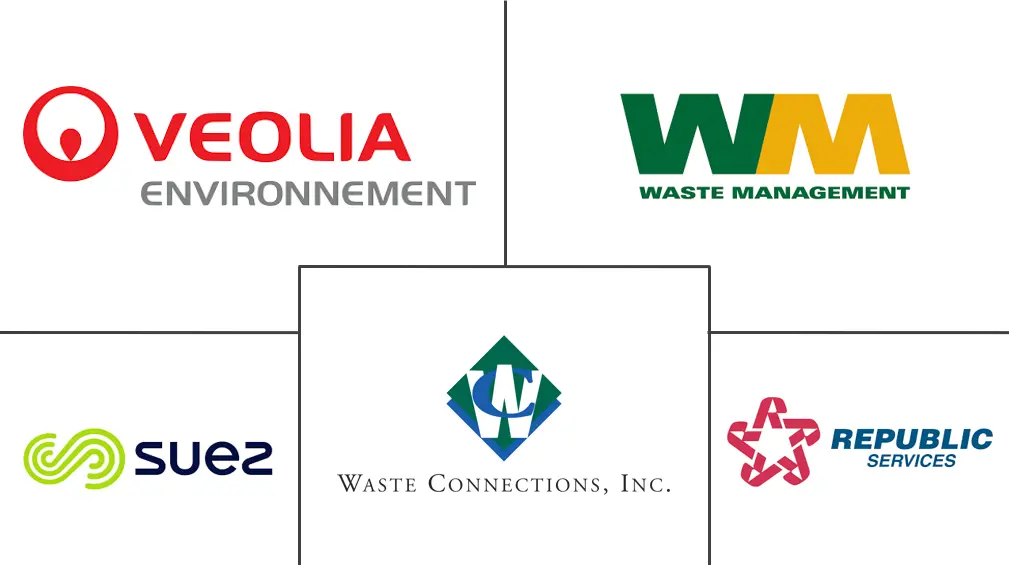
Waste Management Market Analysis by Mordor Intelligence
The Waste Management Market size is estimated at USD 1.43 trillion in 2025, and is expected to reach USD 1.97 trillion by 2030, at a CAGR of greater than 6.62% during the forecast period (2025-2030).
Persistent regulatory pressure, expanding corporate zero-waste pledges, and the monetization of recovered materials are steering the waste management market away from landfill-centric models and toward integrated recovery systems. Extended Producer Responsibility (EPR) statutes in the European Union and several U.S. states are transferring disposal costs to brand owners, creating dedicated funding pools for recycling infrastructure.[1]European Commission, “Waste Shipments Regulation 2024,” At the same time, the roll-out of mandatory digital tracking platforms by the U.S. EPA and the EU is spawning new data-driven service niches, while investments in waste-to-energy (WtE) facilities equipped with carbon-capture technology are unlocking carbon-negative revenue streams. Asia-Pacific held the largest regional position in 2024, and Middle East & Africa (MEA) is on track to be the fastest-growing geography through 2030 as governments allocate capital to diversion targets. E-waste represents the highest-velocity waste stream, propelled by looming electric-vehicle battery retirements.
Key Report Takeaways
- By source, residential waste led with 46.54% of waste management market share in 2024; industrial waste is projected to expand at an 8.3% CAGR through 2030.
- By service type, landfill operations accounted for 52.45% of the waste management market size in 2024, while recycling and resource recovery services are set to grow at a 6.8% CAGR.
- By waste type, municipal solid waste controlled 46.78% of the waste management market share in 2024; e-waste is the fastest-growing segment at a 10.2% CAGR.
- By geography, Asia-Pacific dominated the waste management market with 56% revenue share in 2024, whereas MEA is forecast to be the fastest region at a 9.1% CAGR to 2030.
Global Waste Management Market Trends and Insights
Drivers Impact Analysis
| Driver | (~) % Impact on CAGR Forecast | Geographic Relevance | Impact Timeline |
|---|---|---|---|
| Extended Producer Responsibility regulation | +1.2% | EU, North America, spill-over to Asia-Pacific | Medium term (2–4 years) |
| Carbon-negative WtE investments | +0.8% | Developed markets worldwide | Long term (≥4 years) |
| Corporate zero-waste pledges | +0.7% | Asia-Pacific core, expanding to MEA | Short term (≤2 years) |
| Mandatory digital waste tracking | +0.5% | North America & EU, early adoption in Asia-Pacific | Medium term (2–4 years) |
| Source: Mordor Intelligence | |||
Extended Producer Responsibility regulations in EU & North America
Mandatory EPR schemes now require producers to finance collection and recycling, reshaping the cost base for the waste management market. California’s SB 54 compels a 25% plastic-packaging reduction by 2032 along with a 65% recycling rate, and Minnesota joined five other U.S. states with its own 2024 EPR law. The EU extended EPR to textiles in 2023, creating new compliance markets that have encouraged waste-management operators to consolidate and invest in optical-sorting and polymer-identification lines to capture EPR-funded contracts. Comparable rules introduced in Kenya in 2024 demonstrate global diffusion of the model.
Carbon-negative targets driving WtE investments
Net-zero commitments are channeling capital toward WtE plants equipped with post-combustion carbon capture. Metro Vancouver’s facility, processing 720 t/day of refuse, placed a USD 101 million price tag on equipment that will remove 300,000 tCO₂ annually, flipping the emissions balance from positive to negative.[2]U.S. Environmental Protection Agency, “e-Manifest Program Updates,” In Saudi Arabia, a WtE program converting 3 million t of municipal solid waste into fuel aims to cut 1.79 million tCO₂ per year while delivering renewable electricity to the grid. Access to carbon credit markets adds a new income layer for operators.
Corporate zero-waste pledges spurring industrial recycling contracts in Asia
Global manufacturers are demanding guaranteed diversion rates from suppliers. Samsung recycled 97% of the 1.3 million t of waste generated at its facilities in 2023 and targets 99.9% by 2030. Apple’s plan to remove all waste to landfill across its supply chain has triggered long-term offtake agreements for high-purity plastics and metals. Automotive major Stellantis aims for 90% waste recovery by 2030, catalyzing investments in closed-loop material hubs located in Southeast Asian clusters.
Mandatory digital tracking of waste flows in the U.S. and EU
The U.S. EPA added hazardous-waste exports to its e-Manifest in January 2025, obliging exporters to submit real-time digital records and fees. The EU’s new electronic shipment system becomes compulsory in 2026, promising traceability and stronger enforcement. IoT pilots in Qatar prove that sensor-based route optimization can slash fuel use and overtime costs, underpinning adoption in city contracts.[3]ScienceDirect, “IoT-Enabled Waste Collection Study,”
Restraints Impact Analysis
| Restraint | (~) % Impact on CAGR Forecast | Geographic Relevance | Impact Timeline |
|---|---|---|---|
| Fragmented informal sector dominance | -0.9% | South Asia & Sub-Saharan Africa | Long term (≥4 years) |
| Volatile recovered-commodity prices | -0.8% | Global | Short term (≤2 years) |
| Source: Mordor Intelligence | |||
Fragmented informal sector dominance in South Asia & Africa
An extensive informal workforce limits formal penetration of the waste management market. South Africa leaves 3.67 million t of household waste uncollected each year, fostering illegal dumping and eroding municipal revenues. Informal e-waste recycling in South Asia exposes workers to heavy metals, discouraging institutional investors from funding modern plants. Integrating these workers into regulated value chains requires training and capital that many local operators cannot finance, keeping collection rates low and leakage high.
Volatile recovered-commodity prices disincentivizing recycling investment
Revenue from secondary materials swings with global spot markets: U.S. aluminum-can prices rose to 77.5 cents/lb in 2024 while steel-can values fell to USD 155/t, down 36% year-on-year. Such gyrations complicate payback calculations for mechanical or chemical recycling lines. China’s ongoing ban on plastic-waste imports rerouted flows to lower-regulation destinations, increasing oversupply and depressing margins. As a result, financiers demand a higher internal rate of return thresholds, slowing facility roll-outs.
Segment Analysis
By Source: Industrial Streams Drive Growth
Industrial waste retained the highest momentum in 2024 and is on course to post an 8.3% CAGR to 2030, while residential waste accounted for the largest 46.54% waste management market share that same year. Corporate emissions-reduction mandates are causing manufacturers to treat production scrap as a resource, boosting demand for on-site baling, solvent recovery, and closed-loop logistics. Eastman’s USD 2.25 billion molecular-recycling roll-out, designed to handle 250 million lb of complex plastics annually, illustrates the scale of industrial opportunities. The shift is especially notable in electronics, automotive, and consumer-goods plants concentrated in China and ASEAN nations.
Residential streams, although mature, remain essential to the overall waste management market size because of rising urbanization. Governments are installing color-coded curbside programs and food-waste digesters to comply with landfill-diversion targets. Commercial waste from retail chains adds stable growth as EPR fees fund front-of-store collection infrastructure. Construction-and-demolition waste has gained policy attention; India’s revised C&D rules, effective April 2025, oblige megaprojects to use recycled aggregates, generating predictable tonnage for crushers. Medical and agricultural wastes represent niche but expanding categories, with infectious-waste protocols tightened post-pandemic and agricultural biomass feeding anaerobic-digestion plants in rural zones.
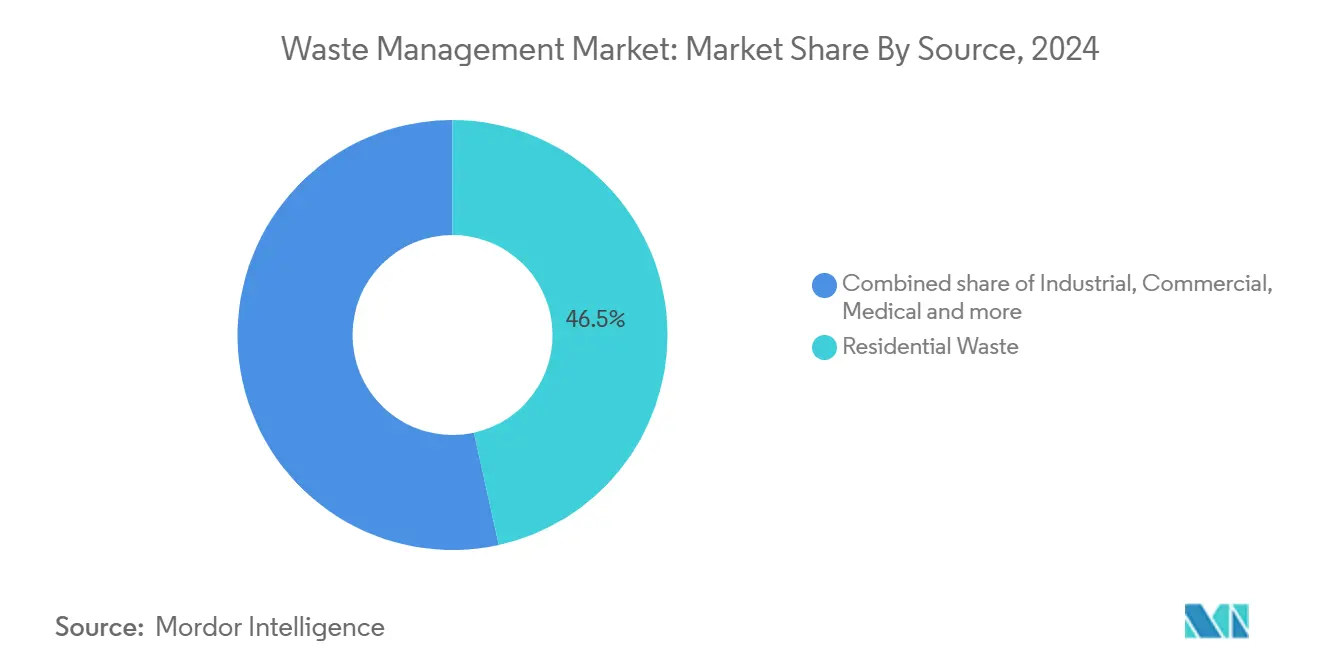
Note: Segment shares of all individual segments available upon report purchase
By Service Type: Recovery Gains on Disposal
Landfills remained the highest-revenue service in 2024, responsible for 52.45% of waste management market size, yet recycling and resource-recovery offerings are tracking a 6.8% CAGR to 2030 as policy penalizes disposal. Cities from Riyadh to Vancouver are moving to variable-rate pricing and landfill taxes that make diversion economically attractive. Saudi Arabia’s Jeddah WtE plant will process 3,000 t/day, producing more than 250 MW of electricity and displacing fossil back-up generation. Incineration and WtE services benefit further from carbon-capture retrofits, turning a compliance expense into a credit asset.
Collection, transport, and material-recovery-facility (MRF) sorting enjoy a margin lift from IoT optimisation. Sensors feed route algorithms that cut overtime by double-digit percentages while boosting route density. Chemical treatment and composting are surfacing as premium services for hazardous and organic fractions, respectively. Consulting, audit, and ESG-reporting modules now command high hourly rates because companies need third-party verification of diversion metrics to satisfy board-level sustainability pledges. The U.S. Solid Waste Infrastructure for Recycling grant program directs USD 275 million to municipalities between 2022-2026, underwriting the local capex required to transition away from dumping.
By Waste Type: E-waste Acceleration
Municipal solid waste held the top position with 46.78% waste management market share in 2024, owing to sheer tonnage, yet e-waste is forecast to grow at a 10.2% CAGR. Lithium-ion battery retirement is emerging as a marquee sub-segment: Malaysia alone expects 870,000 EV packs to hit end-of-life by 2050. The EU Battery Regulation mandates specific lithium-recovery rates, channeling feedstock to certified recycling lines run by Umicore and BASF. In the U.K., authorities anticipate 28,000 tones of EV batteries needing treatment by 2030, soaring to 235,000 tones by 2040, stimulating private-equity funding for hydrometallurgical and direct-regeneration technologies.
Hazardous industrial waste represents an attractive, high-barrier niche. Clean Harbors operates nine commercial incinerators in the U.S. and re-refined 196 million gallons of used oil back into lubricant markets in 2024. Plastic waste faces new restrictions: the EU’s export ban to non-OECD nations begins phasing in during 2026, compelling domestic chemical-recycling capacity. Biomedical waste volumes stabilized after the pandemic spike, yet remain above pre-2020 levels as hospitals adopt higher single-use ratios. Construction & demolition debris is benefiting from recycled-aggregate mandates, and agricultural organics feed biogas digesters, adding renewable-energy revenue streams to farm collectives.
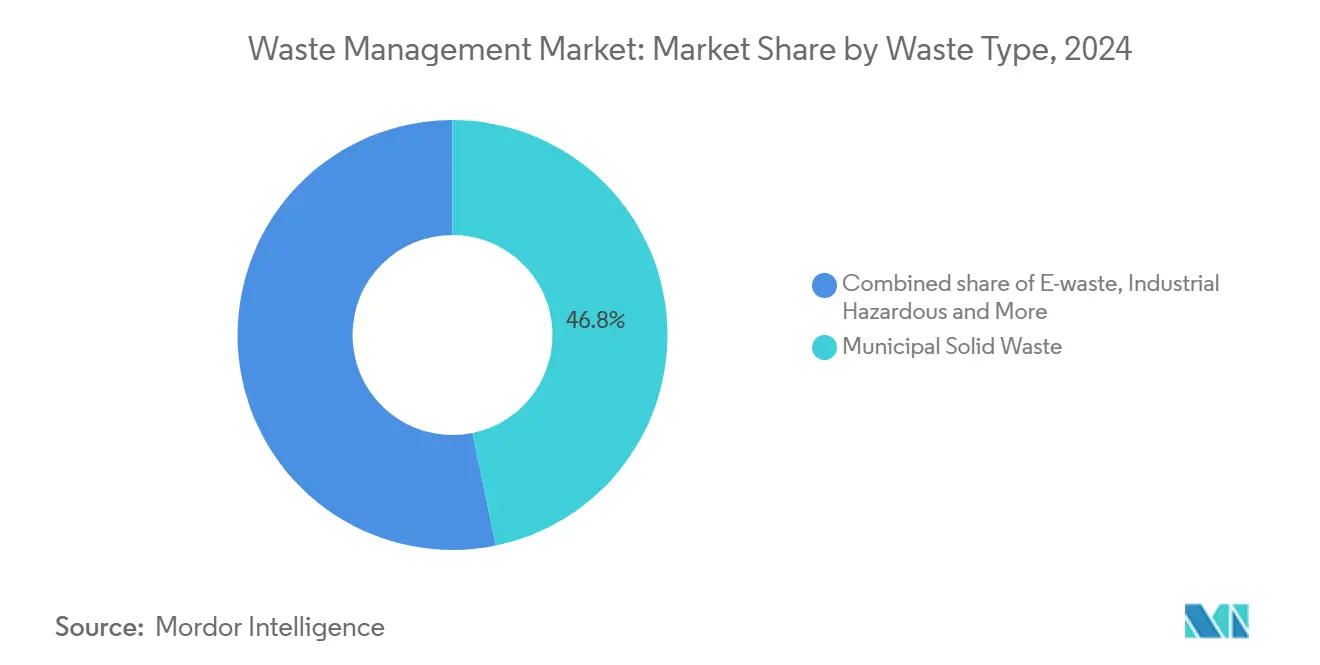
Note: Segment shares of all individual segments available upon report purchase
Geography Analysis
Asia-Pacific contributed 56% of 2024 global revenue in the waste management market, powered by dense manufacturing clusters and rapid urban migration that generate multi-material waste flows requiring advanced processing. China’s Circular-Economy Promotion Law and Japan’s Plastic Resource-Circulation Act obligate producers to design for recyclability, while India’s new rules demand recycled sand and aggregate in public infrastructure. Urban authorities in Shenzhen, Tokyo, and Bengaluru have introduced pay-as-you-throw pricing that boosts household separation at source. Multinationals such as Microsoft, which achieved an 85% construction-waste diversion rate at its new Singapore data center, are executing regional recycling contracts to fulfill zero-waste pledges.
The Middle East & Africa is the fastest-expanding region in the waste management market, flashing a 9.1% CAGR outlook through 2030. Saudi Investment Recycling Company (SIRC) is deploying USD 625 million across refuse-derived-fuel and tire-to-oil facilities to meet Vision 2030 circular-economy milestones. The GCC Waste-to-Energy Cooperation Protocol, signed in February 2025, sets a 40% landfill-diversion target, galvanising plant EPC pipelines in Abu Dhabi, Manama, and Jeddah. Simultaneously, South Africa and Kenya are piloting digital registry systems to formalise informal collectors, though capacity gaps persist outside capital regions.
North America and Europe are mature but regulation-intensive markets. The U.S. EPA’s 2025 mandate that all hazardous-waste exports traverse the e-Manifest expands data-compliance revenue. The White House strategy to phase out single-use plastics from federal procurement by 2027 is expected to ripple through supplier contracts. Europe’s Waste Shipments Regulation, effective May 2024, restricts exports to non-OECD countries and requires end-to-end digital tracking by 2026.
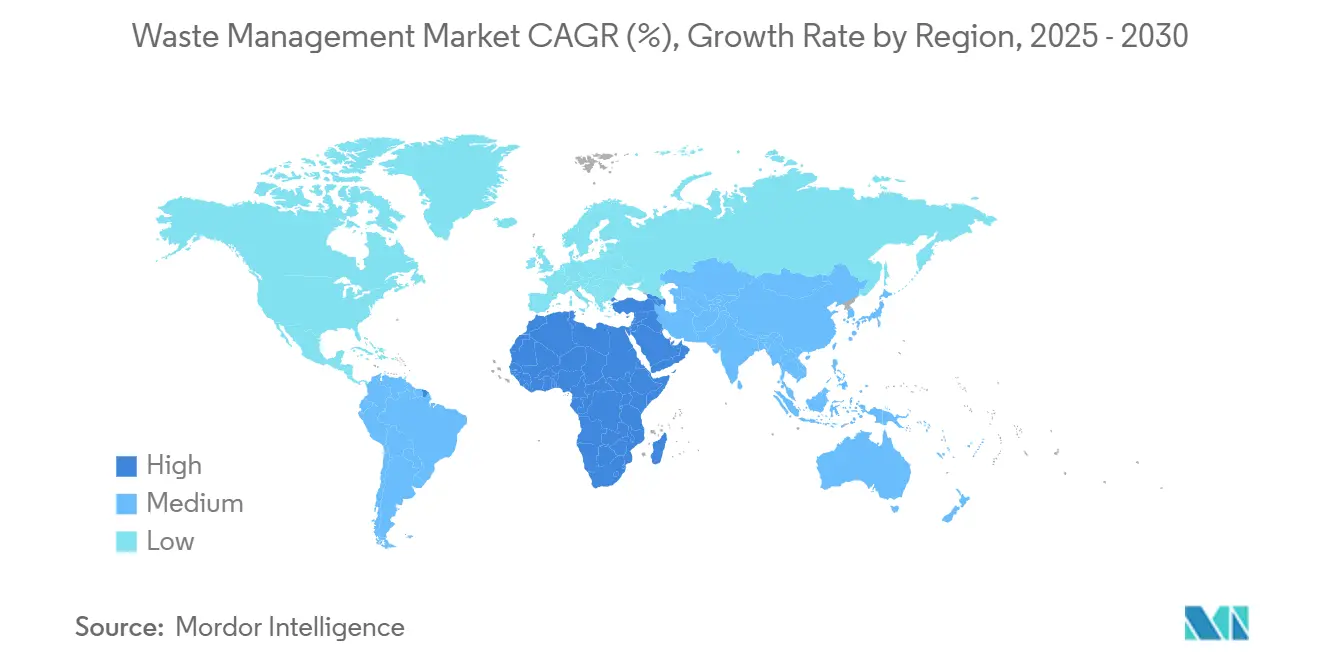
Note: Segment shares of all individual regions available upon report purchase
Competitive Landscape
The waste management market competitive field is moderately fragmented yet consolidating, as illustrated by Waste Management’s USD 7 billion takeover of Stericycle in November 2024, which combined municipal, medical, and secure-destruction capabilities under one roof. Large operators are adopting vertical integration to offer cradle-to-recovery contracts that guarantee diversion rates and carbon accounting, locking in enterprise customers looking for single-invoice solutions.
Strategic investment themes revolve around technology. Veolia spent USD 40 million upgrading its Richmond wastewater plant in 2024 with advanced odor control and nutrient recovery, delivering compliance plus material-reuse value. SECURE Energy Services earmarked USD 175 million for metals-recycling acquisitions, signalling a pivot from upstream oil-field waste to high-margin urban scrap flows. Clean Harbors, meanwhile, reported a 35.8% revenue jump in 2024 from hazardous-waste services, driven by rising demand for PFAS incineration and battery-waste treatment.
Private equity remains active: Berkshire Partners recapitalized Triumvirate Environmental to chase regulated-medical-waste growth across the northeast U.S. Deal flow is strongest in segments that command regulatory moats hazardous waste, WtE, and digital-tracking software. Start-ups offering blockchain-enabled tracing are securing pilot contracts with brand owners eager to validate recycled-content claims, widening the competitive perimeter beyond traditional haulers.
Waste Management Industry Leaders
-
Veolia Environment SA
-
Waste Management Inc.
-
Suez SA
-
Republic Services Inc.
-
Waste Connections Inc.
- *Disclaimer: Major Players sorted in no particular order
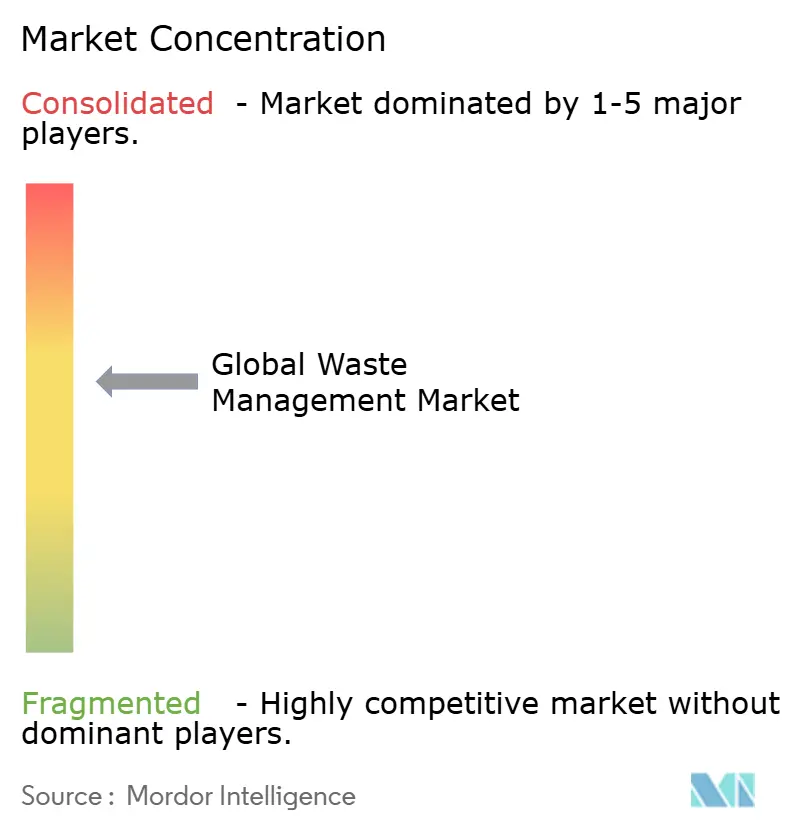
Recent Industry Developments
- May 2025: SIRC and EIG agreed on USD 625 million of waste-infrastructure projects covering refuse-derived-fuel and tire-recycling lines in Saudi Arabia.
- March 2025: Metro Vancouver published a feasibility study showing a USD 101 million investment is required to capture 300,000 tCO₂ annually at its WtE facility.
- February 2025: The GCC signed a regional Waste-to-Energy Cooperation Protocol, aiming for 40% municipal waste diversion by 2030 with USD 58 billion committed across member states.
- January 2025: The U.S. EPA fully integrated hazardous-waste exports into the e-Manifest digital platform, obliging exporters to submit electronic manifests and user fees.
Research Methodology Framework and Report Scope
Market Definitions and Key Coverage
Our study defines the global waste management market as the annual revenue earned by licensed operators that collect, transport, sort, treat, recycle, and finally dispose of solid and liquid waste arising from residential, commercial, and industrial sources. Activities counted cover landfill operations, controlled incineration, material-recovery facilities, and the supporting logistics and monitoring that make these steps possible.
Scope Exclusions: Informal scavenging, on-site industrial remediation jobs, and sales of electricity or heat from waste-to-energy plants fall outside this sizing.
Segmentation Overview
- By Source
- Residential
- Commercial (Retail, Office, etc.)
- Industrial
- Medical (Health and Pharmaceutical)
- Construction & Demolition
- Others (Institutional, Agricultural, etc)
- By Service Type
- Collection, Transportation, Sorting & Segregation
- Disposal / Treatment
- Landfill
- Recycling & Resource Recovery
- Incineration & Waste-to-Energy
- Others (Chemical Treatment, Composting, etc.)
- Others (Consulting, Audit & Training, etc.)
- By Waste Type
- Municipal Solid Waste
- Industrial Hazardous Waste
- E-waste
- Plastic Waste
- Biomedical Waste
- Construction & Demolition Waste
- Agricultural Waste
- Other Specialized Waste (Radio Active, etc.)
- By Geography
- North America
- United States
- Canada
- Mexico
- South America
- Brazil
- Argentina
- Rest of South America
- Asia-Pacific
- China
- Japan
- India
- South Korea
- ASEAN (Indonesia, Thailand, Philippines, Malaysia, Vietnam)
- Australia
- Rest of Asia-Pacific
- Europe
- United Kingdom
- Germany
- France
- Italy
- Spain
- Russia
- BENELUX (Belgium, Netherlands, and Luxembourg)
- NORDICS (Denmark, Finland, Iceland, Norway, and Sweden)
- Rest of Europe
- Middle East and Africa
- Saudi Arabia
- United Arab Emirates
- Qatar
- Turkey
- South Africa
- Egypt
- Nigeria
- Rest of Middle East and Africa
- North America
Detailed Research Methodology and Data Validation
Primary Research
Mordor analysts interviewed municipal solid-waste directors, private haulers, landfill engineers, technology vendors, and environmental regulators across North America, Europe, Asia-Pacific, and the Gulf. These conversations validated prevailing average selling prices, recovery yields, and likely policy shifts, filling gaps the public domain leaves and guiding the final triangulation.
Desk Research
We reviewed open datasets from authorities such as the World Bank, Eurostat, the US EPA, and UNEP for generation rates, tipping fees, and recycling targets. Trade bodies (ISWA, PlasticsEurope, WEEE Forum) added sector-specific insights, while company 10-Ks, bond prospectuses, and investor decks revealed service pricing and margin profiles. Paid feeds on D&B Hoovers and Dow Jones Factiva helped us triangulate contractor revenues. The sources cited illustrate our desk work and are not exhaustive.
Market-Sizing & Forecasting
A top-down build begins with country waste-generation tables multiplied by blended disposal and recycling fees. Results are then checked against sampled ASP × tonnage estimates from leading contractors to fine-tune totals. Variables that drive the model include per-capita waste output, urbanization rates, landfill tipping fees, Extended Producer Responsibility deadlines, recycled-commodity prices, and GDP growth. Multivariate regression translates each driver's projected path into volume and value forecasts, and scenario analysis tests policy-shift sensitivities.
Data Validation & Update Cycle
Outputs run through anomaly screens that flag deviations from historic elasticities, followed by two peer-review passes and senior-analyst sign-off. Reports refresh every twelve months, with interim updates issued when material regulatory or M&A events occur.
Why Mordor's Waste Management Baseline Earns Trust
Published numbers often diverge because firms adopt different waste streams, price bases, or refresh schedules. By fixing a transparent scope and refreshing annually, we limit such skews and give clients a consistent yardstick.
Key gap drivers include whether biomedical and remediation fees are bundled, how informal-sector leakage is treated, currency-year choices, and the timing of price escalators applied to landfill and recycling revenues.
Benchmark comparison
| Market Size | Anonymized source | Primary gap driver |
|---|---|---|
| 1.43 trillion | Mordor Intelligence | - |
| 1.50 trillion | Global Consultancy A | Bundles energy sales and remediation services, inflating totals |
| 1.28 trillion | Industry Association B | Uses constant-2019 pricing and omits informal-sector leakage adjustment |
These contrasts show that Mordor's clearly bounded scope, fresh pricing benchmarks, and dual-step validation deliver a balanced, traceable baseline decision-makers can rely on.
Key Questions Answered in the Report
What is the current size of the waste management market?
The waste management market generated USD 1.43 trillion in 2024 and is projected to climb to USD 1.97 trillion by 2030.
Which region leads the waste management market?
Asia-Pacific held 56% of global revenue in 2024 thanks to dense manufacturing bases and urban population growth.
Which waste type is growing fastest?
E-waste is expanding at a 10.2% CAGR through 2030, driven largely by end-of-life electric-vehicle batteries.
What service segment is seeing the quickest growth?
Recycling and resource-recovery services are rising at a 6.8% CAGR as regulations penalize landfill disposal.
How will Extended Producer Responsibility influence the market?
EPR shifts recycling costs from municipalities to brand owners, unlocking new revenue for collectors and processors while accelerating infrastructure upgrades.
Why are carbon-capture retrofits important for WtE plants?
They allow operators to achieve carbon-negative profiles, opening up extra revenue through carbon credits and supporting decarbonization mandates.
Page last updated on:
